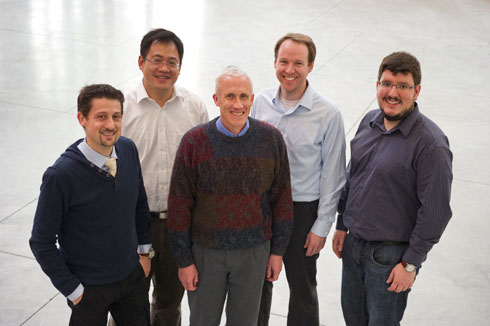
New NSE faculty drive curriculum expansion into computational science and engineering
Since the earliest days of science, the interplay of theory and experimentation has been the primary method of creating new knowledge. Today, the affordability of massive computing power has added a third tool to the researcher’s workbench: computational modeling and simulation, which is rapidly being integrated across the NSE curriculum by a group of new faculty members with in-depth experience.
“In the past, science and engineering relied on experimentation and theory, aided by relatively simple calculations,” notes Ju Li, who holds professorships in both NSE and Materials Science and Engineering, and who led the development of a newly offered course, Computational Nuclear Science and Engineering. “Now, computer simulation has become the third leg of scientific inquiry and engineering, which supplements what we find with experimentation and theory.”
The combination of the three brings unprecedented power to bear on challenges like developing new nuclear materials, designing reactor components, and assessing complex system-level interactions, in fission, fusion and radiation technology applications.
Li notes that experimental and theoretical methods are certainly not being replaced, but that computer simulations can address some of their limitations. “Experimentation often produces only a few critical pieces of measurement, and you typically can’t have perfect initial and boundary conditions. Analytical theory gives big-picture insights, but it has to take a simplified view of the world. So in complex systems, when there are many parameters, or when systems are coupled together, it becomes intractable. Simulation is very data-rich, so one can see how internal states are coupled, and one can do parametric studies, which are sometimes difficult to do experimentally.”
The new computational science and engineering course, 22.107, will give NSE grad students what Li calls “intermediate-level proficiency” in three core skills: programming, mathematical understanding of algorithms, and construction and interpretation of models. “Our grad students have diverse backgrounds – mechanical engineering, chemistry, physics – and they will enter diverse fields after graduation. But being able to identify problems that are amenable to computer-aided solutions, and then actually implementing the programming and debugging, and interpreting the results, will all be key survival skills.”
More broadly, computational methods are already being integrated into many NSE courses, says Assistant Professor Ben Forget. “I teach reactor physics for juniors, and we’re including some programming exercises, which provide a good introduction. And Professor Kord Smith, who leads an NSE task force on identifying new frontiers in simulation, also took the students in our reactor physics class and our class on fuel cycles to Studsvik Scandpower, a company he co-founded that makes core design software. Studsvik has been very generous, letting us use their training facilities; we’d like to continue that collaboration, and perhaps even replicate some of their training environment here at MIT.”
Forget notes that while integrated programs like MATLAB make setting up simulations very convenient, students will also be expected to build models from the ground up. “When you make the step to an industrial application, you will often need expertise in compiled languages like C++ and Fortran. We’re not teaching one language or one skill; we want students to learn to program, so they’ll be able to switch between languages without too much trouble.”
Forget adds that many newly hired department faculty, including himself, Li, Smith, Emilio Baglietto and Felix Parra, have extensive backgrounds in computational methods. “We’re building critical mass, and creating a network,” he says. “We hope to really leverage that in the next few years; there’s certainly a lot of potential for collaboration.” NSE is also seeking synergies with other Institute departments where computation is increasingly important, like aero-astro engineering, civil & environmental engineering, and mechanical engineering.
The expected result: tighter integration of computational technologies with experimentation and theory, and better odds of solving the knottiest challenges. As Li says, “Most of the problems we’re dealing with today are very difficult. To work on the border of what’s do-able, we need to couple all three together.”
The expected result: tighter integration of computational technologies with experimentation and theory, and better odds of solving the knottiest challenges.
In the photo from L to R:
Emilio Baglietto, Ju Li, Kord Smith, Benoit Forget, Felix Parra.
Written by Peter Dunn
Photo by Justin Knight
Related
- New NSE strategy strengthens core, opens boundaries; seeks better integration of technical and societal issues
- Nuclear security takes its place in NSE’s curriculum
